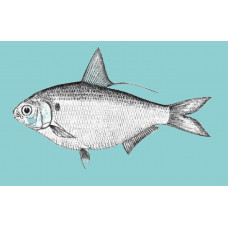Latin name
Nematalosa come
Other name
Nematalosa come
Identification
Abdomen with 18 or 19 (rarely 20) + 10-13 (usually 11 or 12) scutes, total of 29 to 31 (usually 30). Anterior spur of preoperculum with fleshy triangular area above, not covered by third infraorbital bone. The edge of the lower jaw is strongly expanded outwards. Thoracic axillary scales well developed. Posterior margin of scales without denticles.
Features of fish fins
Dorsal spines (total): 0; Anal spines: 0; Anal soft rays: 17-26.
Fish colouring
There is a dark spot behind the gill slit.
Distribution
Western Pacific: from the Ryukyu Islands to Queensland, Australia and Papua New Guinea.
Habitat
Tropical marine pelagic-neritic species. Depth range ? - 13 м.
Size
Maximum length 21 cm, normal length 16.5 cm.
Behavior
Occurs near shore. Gathers in large schools to spawn.
Food and feeding habits
They feed on planktonic invertebrates.
Reproduction
A large number of eggs and mollies are released into the water at the same time. Fertilization occurs randomly, without mate selection. Parental care is absent, but due to the large number of eggs, a small proportion of fry survive to sexual maturity.
Fishing
These fish are caught by natural methods, using rods, spinning, nets and so on.
Relationship with a person
Harmless.
| Classification | |
| Phylum | Chordata |
| Class | Actinopterygii |
| Squad | Clupeiformes |
| Family | Dorosomatidae |
| Genus | Nematalosa |
| Species | N. come |
| Features | |
| Conservation status | Least Concern |
| Habitat | Pelagic |
| Life span, years | No information |
| Maximum body weight, kg | No information |
| Maximum length, cm | 21 |
| Sailing speed, m/s | No information |
| Threat to people | Edible |
| Way of eating | Planktonophage |

